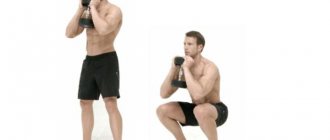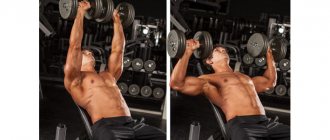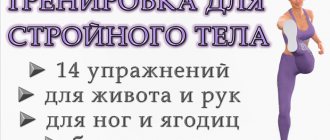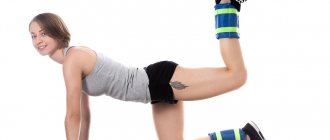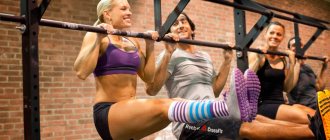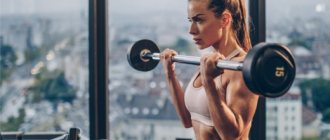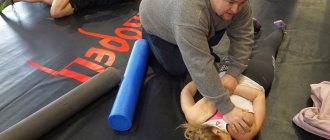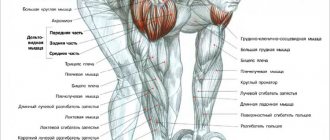Even with a meager arsenal of exercise equipment, you can create a good program for strength training at home. Yes, it may be inferior to a program created taking into account the wide variety of exercise equipment in the gym. But this option will require minimal investment from you - the only sports equipment you will need are collapsible dumbbells with a sufficient number of weights . A wide variety of exercises with dumbbells allows you to exercise almost all muscle groups in the upper body. With legs it will be more difficult, but even here there are a couple of solutions.
How to determine working weight?
Using a simple experiment: start doing an exercise with a certain weight. If after 8 repetitions you have the strength to continue doing the exercise, the weight is too light. Increase it until 8-10 repetitions allow you to perform the exercises to the limit of your capabilities without compromising your technique.
An exception
The experiment above works well for many exercises other than basic leg exercises (like dumbbell squats or dumbbell deadlifts). In them, it is better not to repeat the exercise to failure, as this is associated with the risk of loss of control over the weight, falling and injury.
Instead, just take the maximum possible weight with which you can perform 5 repetitions without compromising your form (that is, with a straight back, arched lower back, etc.). After this, substitute the working weight into the formula (WORKING WEIGHT * 1.09703) + 14.2546. This is how you calculate your one-time maximum. Now multiply your one-time maximum by 0.8. This will be your working weight in basic leg exercises - squats and deadlifts!
You may have different lifting weights for different exercises, so it makes sense to experiment with each one on the list in this program.
As you progress, the working weights will increase, so it will be great if you have a couple of extra dumbbell plates in reserve.
The benefits of cardio training
In addition to burning calories and increasing endurance, cardio exercises:
- ventilate the lungs and saturate the body cells with oxygen;
- train the heart muscle, reducing the risk of heart attack;
- act as a prevention of atherosclerosis, hypertension and diabetes;
- speed up metabolism;
- normalize hormonal levels and improve skin condition;
- reduce the level of “bad” cholesterol;
- strengthen bone tissue;
- promote the production of endorphins, which increases the body's resistance to stress;
- normalize the activity of the central nervous system;
- They tone up overall and increase energy.
The success and benefits of any type of cardio training depend on proper nutrition. Only a diet with a large amount of complex carbohydrates and protein will help maintain strength, energy and normalize the functioning of all body systems. Such loads are recommended for several categories of the population at once. Thus, moderate cardio exercises help older people maintain the condition of the heart and blood vessels and prolong the years of active life. Combining cardio and strength training allows overweight trainees to get the body of their dreams. In addition, cardio helps develop endurance during cyclic sports and allows you to recover from intense exercise and overtraining.
Who is this program for?
This program is best suited for beginner athletes: there are no complex movements, and the technique of most exercises is easy to master. The program includes exercises for all key muscle groups, both isolation and compound compound exercises, which can work to increase testosterone and growth hormone levels.
The program can also be used by advanced athletes who temporarily cannot afford to go to the gym. Outside the gym, it will help not only maintain, but also gain muscle. The latter can be achieved by progressing in working weights and using advanced techniques - for example, drop sets or forced reps.
Let's sum it up
Using exclusively dumbbells and a bench for training cannot be considered a disadvantage. After all, they allow you to train every muscle group in the comfort and safety of your home. You can also work out at absolutely any time - because your home gym is never closed! If you simply exercise diligently, eat right, and get enough sleep, the above workouts will help you become stronger and more muscular.
Source:
https://fitnessvolt.com/best-dumbbell-workout/
Rules for effective training
- The workout should not last longer than 45 minutes.
- After 2-3 months, the training program loses its effectiveness, so it is worth changing it.
- It is better not to stretch pauses between repetitions longer than 2-3 minutes, unless you feel an urgent need for it.
- Try to keep your working weight up from workout to workout.
- Do basic exercises at the beginning of your workout, isolation exercises at the end.
- Don't chase heavy weights that prevent you from performing technique. Technique is the main thing!
Contraindications
Despite the fact that cardio training is beneficial for a large number of people, it should be said that it is harmful for some categories. For example, exercise is not recommended for infectious and oncological diseases, diabetes and severe cardiac disorders.
Also, the possibility of performing exercises with caution is discussed in case of obesity, asthma, joint diseases, intervertebral hernias in the post-infarction state. The presence of the listed diagnoses requires mandatory consultation with a doctor, who will consider the advisability of such activities and potential benefits for the body.
It is strictly forbidden to train if you have the following problems:
- respiratory diseases;
- allergic manifestations in acute form;
- ulcers in the gastrointestinal tract;
- chronic processes in the acute stage.
Dumbbell training program
Monday: Chest-Biceps
#1 Dumbbell Bench Press
One of the best basic exercises for working the chest. Usually performed with a barbell, but the dumbbell version allows for a better stretch of the pecs at the bottom.
Work: Mainly - pectoral (pectoral) muscles, secondarily - the anterior delta and triceps.
How much to do: 4 sets of 10 repetitions
Technique: Sit on a bench with dumbbells, move your arms to the sides so that the angle is right. As you inhale, press the dumbbells up, pause at the top point and exhale. Lower the dumbbells to the starting position.
If there is no bench: The exercise can also be done on the floor. The disadvantage of this technique is that at the bottom point the dumbbells will not be suspended and the chest muscles will not stretch.
#2 Weighted push-ups with high feet
As an option, instead of weights, you can do push-ups with an expander.
Typically, a barbell or dumbbell press on an incline bench is performed on the top of the pecs. Since you may not have it at home, it is advisable to replace incline presses with push-ups with high legs positioned with weights in the form of a backpack with a load.
Work: Mainly - the top of the pecs, secondarily - the anterior delta and triceps
Preparation: Here you will need a weighted backpack. You can hide dumbbells or a few water bottles in it. If doing push-ups with weights is difficult, start without it, and over time add weight to your backpack.
How much to do: 4 sets of 10 repetitions
Technique: Throw your legs onto any surface elevated above the floor - a bench, chair or bed. Palms are shoulder-width apart. The arms are almost straightened. Slowly lower yourself down until your forehead is a few centimeters from the floor. Hold for a second and slowly return to the starting position.
#3 Standing dumbbell curls with supination
One of the most popular biceps exercises. It can be performed without turning the hand, but in this case the effectiveness of the exercise will decrease.
Works: Biceps. To a lesser extent - brachioradialis and brachialis.
How much to do: 4 sets of 10 repetitions
Technique: Stand up straight, hold dumbbells in your hands, palms facing your body. Raise the right dumbbell up, turning your palm towards you (this is called supination). Pause at the top and slowly return the dumbbell to the starting position. Repeat the same with the other hand.
A detailed analysis of the technology is here.
#4 Standing spider curls
Works: Biceps. To a lesser extent, brachialis.
Spider curls are usually performed on an incline or Scott bench. The option without them is no worse: the main thing is to take a stable position.
How much to do: 4 sets of 10 repetitions
Technique: Bend forward so that your elbows are tucked between your thighs. Dumbbells - on straight arms, gaze directed to the floor, neck continues the line of the spine. Press the dumbbells up toward your chest. At the top point, pause and slowly return to the starting position.
A detailed analysis of the technology is here.
#5 Concentrated curls
A good exercise for the peak of the biceps. They can be used to finish off the target muscle at the end of the workout.
Works: Biceps. To a lesser extent, brachialis.
How much to do: 4 sets of 10 repetitions on each arm.
Technique: Sit on a chair or bench. Place your triceps on the inside of your knee. Tighten your biceps and press the dumbbell up, supinating your hand so that your palm faces your face. Pause at the top and slowly return your arm to the starting position. Do a similar exercise with your other hand.
If there is no bench: The exercise can be performed on a chair, stool or bed.
Wednesday: Back-Triceps
#1 Bent-over one-arm dumbbell row
Classic back exercise. Working with one hand allows you to better control the technique, and a wide amplitude allows you to load your lats well.
Among other things, the exercise will help to work out the lagging side of the lats.
Works: Latissimus and teres dorsi muscles. To a lesser extent - diamond-shaped, lower trapezius and rear deltoid.
How much to do: 4 sets of 10 repetitions on each side.
Technique: Place your right knee on the bench and support yourself with your right hand. The angle between the lower leg and thigh is straight, and the back is located at an angle of 45 degrees to the horizontal. In the left hand there is a dumbbell, which is located in a canopy, the shoulder is relaxed. Strain your back and pull the dumbbell to your waist. Pause and slowly return to the starting position. Repeat the same with the other hand.
If you don't have a bench: You can easily replace it with a couple of chairs. The backrests will not interfere, since only one hand works in the exercise.
#2 Standing dumbbell row
A little more difficult in technique than one-arm dumbbell rows. But in it you have no other point of support other than your legs. Due to this, the core muscles are in static tension.
Works: Latissimus and teres dorsi muscles. To a lesser extent - diamond-shaped, lower trapezius and rear deltoid.
How much to do: 4 sets of 10 repetitions.
Technique: Tilt your body 45 degrees to the horizontal and bend your knees slightly so that your butt goes back. The back is straight, dumbbells are on outstretched arms. Pull the dumbbells back, pulling them towards your body. At the top point, tighten your lats and pause. Slowly lower the dumbbells down to the starting position.
#3 Shrugs with dumbbells
Trapezius is a fairly strong muscle. To load them, you should take more weight.
Work: Trapezius muscles, to a lesser extent - rhomboid muscles.
How much to do: 4 sets of 10 repetitions.
Technique: Take dumbbells and stand straight. Turn your palms towards your body. Pull your shoulders up. Pause at the top and slowly lower your shoulders to the starting position.
#4 French press with dumbbell
As in the previous exercise, here you will need more weight, since two hands are working with one dumbbell at once.
Works: Triceps. Accessory muscles: trapezius, rhomboid.
How much to do: 4 sets of 10 repetitions.
Technique : Stand up straight, pick up a dumbbell. Keep your weight on your arms outstretched, elbows slightly bent. The dumbbell is located behind the back of the head. As you inhale, bend your arms so that it goes straight behind your head. Take a break and, as you exhale, return to the starting position.
#5 Narrow push-ups with weights
Triceps push-ups with a narrow arm position are best performed with weights so that the muscles receive enough load for explosive growth. If desired, the hands can be placed even more tightly so that the thumbs and index fingers of adjacent hands form the shape of a rhombus, or diamond. This type of push-up is called diamond push-ups.
Work: Triceps, to a lesser extent - the inner side of the pectorals.
Preparation : You will need weights. For example, a backpack with a load - bottles of water, dumbbells or something equally heavy.
How much to do: 4 sets of 10 repetitions.
Technique: Take a lying position so that your palms are located at a short distance from each other - slightly narrower than shoulder width. As you inhale, slowly lower to the bottom point, pause, and as you exhale, return to the starting position. During the exercise, the elbows should be pressed to the floor and the body should be extended into a string.
Friday: Legs-Shoulders
#1 Deadlift with dumbbells
This is one of the best basic exercises that works several muscle groups at once. Due to this, it causes a good anabolic response, including a surge of growth hormone.
Unlike the classic deadlift with a barbell, the version with dumbbells puts more stress on the forearms and allows for better control of the weight, and therefore is easier from a technical point of view.
Works: gluteus maximus, hamstrings, quadriceps. Auxiliary muscles: trapezius, gluteus minimus, abs, arm muscles.
How much to do: 3 sets of 10 repetitions.
Technique : Stand in front of dumbbells. Sit down, take them so that your palms are facing you. Slowly work your way up, keeping the dumbbells close to your hips. Keep your back straight and maintain a slight arch in your lower back throughout the movement.
#2 Squats with dumbbells
Dumbbells can be held to the sides of the body or in front of you.
See for yourself which option is easier for you to maintain balance. This exercise is much easier to perform than the version with a barbell on your shoulders. That is why it is good for beginners.
Like the barbell option, it can be classified as basic - it loads a large number of muscles and causes the secretion of anabolic hormones.
Works: hamstrings, gluteal muscles. Auxiliary - thigh biceps, lower leg.
How much to do: 3 sets of 10 repetitions.
Technique: Stand up straight, arms along your body, palms facing the body. Inhale, bend your lower back slightly and squat down. As soon as your thighs are parallel to the floor, take a short break and return to the starting position.
#3 Calf raises with dumbbells
The option with a barbell is demonstrated here.
With dumbbells, the technique doesn’t change: you’ll just have a dumbbell in your hands, not a bar. It is best to perform the exercise on a staircase, so that at the bottom point the calves stretch under the weight of the body. As an option, you can stand on a platform, barbell or board. The main thing is that the support is reliable.
Before you do the exercise, practice doing it without weight. You need to learn to keep your balance so as not to fall backwards.
If you are training on stairs, it is safest to hold the dumbbell in only one hand and hold the railing with the other.
Works: Calf and soleus muscles.
How much to do: 4 sets of 10 repetitions.
Technique : Take dumbbells and stand straight. Place your toes on the platform or step so that your heels do not rest on the surface. As you exhale, tense your calves and rise onto your tiptoes so that your heel goes up. At the top point, pause and at the bottom, return to the starting position.
#4 Seated dumbbell press
An excellent exercise for all three deltoids - anterior, middle and posterior. The latter works to a lesser extent, but we will “finish” it in the next exercise.
With heavy weights, it is better to perform the exercise on a chair: the backrest will help the back muscles keep the body vertical.
Function: Three deltoid bundles. Auxiliary - triceps, pectorals.
How much to do: 4 sets of 10 repetitions.
Technique: Sit up straight, look ahead. In the starting position, the angle at the elbows is about 90 degrees, the elbows are exactly under the dumbbells, the dumbbells themselves are at shoulder level. As you inhale, press the dumbbells up so that they come close to each other almost tightly. Pause and slowly lower the dumbbells to the starting position.
If there is no bench: The exercise can be performed on a chair or stool.
#5 Bent-over dumbbell raises
The exercise focuses the load on the rear, most massive deltoids. It is he who sets the main volume of this muscle group, so you should not neglect bent over swings.
Work: Posterior head of deltoid. Auxiliary muscles are the trapezius and rhomboid muscles.
How much to do: 4 sets of 10 repetitions.
Technique: Take a dumbbell in your hands and lean forward so that your body is parallel to the floor. Keep your back straight and slightly arch at the waist. The dumbbells are located below on barely bent arms. As you inhale, lift the dumbbells up as high as possible. Feel the tension in your rear deltoids and pause. Slowly return to the starting position.
Dumbbellsworkout at home
What is cardio exercise?
Cardio training is a type of physical activity in which the heart works at an increased rate, and the source of energy is subcutaneous fat and glycogen. Loads of this kind have a positive effect on the functioning of organs, strengthen blood vessels, develop the respiratory system, increase endurance and help lose weight.
The training is characterized by a minimal set of strength exercises and, although it involves various muscle groups, does not lead to an increase in muscle mass. This type of load is usually present in any fitness program, but is also quite suitable for training at home. In this case, a necessary condition for effectiveness is increased heart rate values.
Exercise accelerates the heart muscle to the required number of contractions, during which the body activates metabolism and biochemical processes. Maintaining the heart rate within the specified limits for 30-60 minutes ensures a high-quality training result, but exceeding the specified limits already poses a health hazard. Therefore, during the lesson, constant monitoring of the state of the above parameters is necessary.
What types of bench presses are there?
Horizontal
This bench is equipped with two racks for installing a barbell; the distance between them can reach 110 cm. The bench allows for performing bench presses only in a horizontal position. Racks can be either stationary or adjustable. The latter are the most universal.
Straight bench press without racks and with racks
Incline bench press
A bench press with a fixed angle, which averages 45 degrees. In such a bench there is no possibility to adjust the angle of inclination, so the design promotes the development, to a greater extent, only of the upper part of the pectoral muscles.
Adjustable Press Bench
This is the most versatile model of the exercise machine, which makes it possible to perform a number of exercises at any angle - lying down, reclining, sitting.
Each type can have racks for a barbell, bolsters for resting the legs and handles for fixing the body.
Triceps workout
Exercise 5: Lying Triceps Extension
- You will need:
a weight bench, a straight barbell, or a barbell with a curved W bar. - What muscles are worked:
triceps. - Performing the exercise:
lie on a bench with your feet on the floor. Hold the barbell with a reverse grip (palms facing your face) or straight grip (easier for beginners), with your hands shoulder-width apart. Without bending your elbows, bend your forearm to lift the bar above your forehead. From this position, extend your forearms to lift the barbell overhead. - Breathing:
inhale in a low position, exhale while lifting the bar. - Safety precautions:
Gently lower the barbell by flexing your forearms. Be careful not to flare your elbows out to the sides as you lower the barbell to your forehead.
Do you need a bench press bench at home?
Of course, you can do without exercise equipment at all, but if your goal is to gain weight and maintain the tone of all the muscles of the body, then you cannot do without at least one universal exercise machine. For a bench press, you also need dumbbells of various weights or a barbell, but provided that the bench has racks. If you want to develop large pectoral muscles and back, without a bench press it is unlikely to achieve results with push-ups alone.
